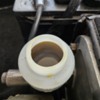Good Morning,
I was driving up hill to park in the garage this weekend and my clutch pedal went to the floor and stayed there for about 2 seconds, luckily, I was in neutral at the time. Since then, the pedal has been sticking at about 1 inch below the fully disengaged level. Once you press the clutch the sticking stops and there are no issues going into gear.
I don't hear noises with the throw out bearing and no leaks.
I've got about 600 miles since rebuilding the car, including new McLoud Clutch, Master and Slave cylinders.
It has been working great up until now.
Maybe there is air in the system and I need to bleed it?
Any ideas are greatly appreciated.
Thanks,
John





